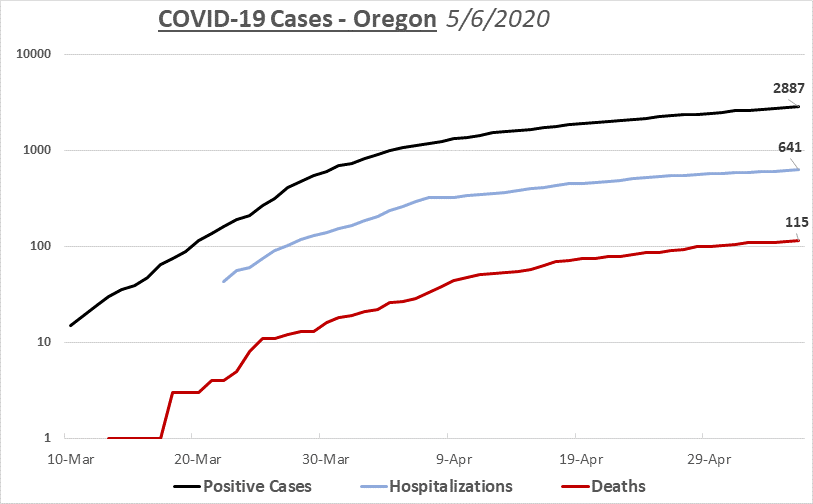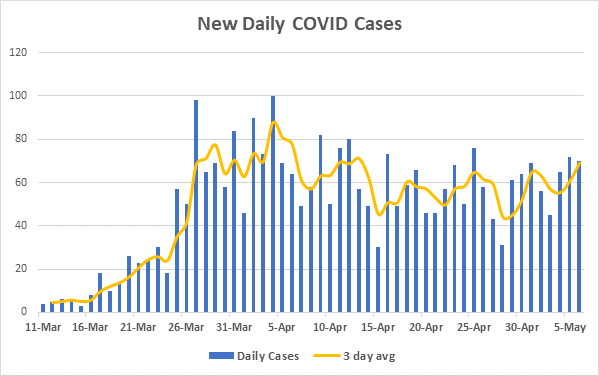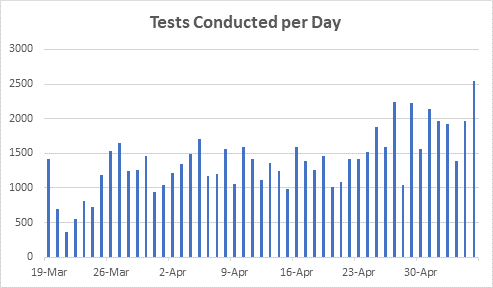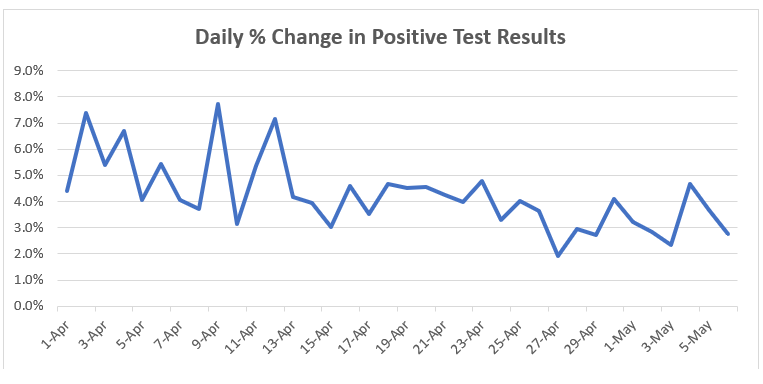|
May 6, 2020
Dear Neighbors and Friends:
I hope that you and your loved ones are doing well, staying healthy, and looking out for your neighbors and friends.
As expected, the Governor will indeed be announcing the details of Phase One of the Reopening Oregon plan, including the specific locations that will be going into Phase One first. You can watch her press conference tomorrow morning at 11 via this link. I’ll give you a detailed summary of what she has to say in tomorrow’s newsletter.
And those of you who will be attending tomorrow evening’s zoom town hall can look forward to additional perspective and reactions from Representatives Smith Warner and Keny-Guyer, Elana Pirtle-Guiney from the Governor’s Office, and me.
Finally, I’ve been asked when legislative committees are going to be holding their interim meetings, given that our May “Legislative Days” will not be held this year because of the pandemic. Plans are starting to firm up for a series of virtual meetings starting with the Revenue Committees on May 20 (when the revenue forecast will be released). It will be followed by a series of House committee hearings during the last part of May and into early June, followed by Senate committee hearings. I expect that most of the hearings will feature topics of particular relevance to the COVID crisis, but there will likely be other issues addressed as well. I’ll let you know more when I know more.
TODAY’S CORONAVIRUS AND CORONAVIRUS RESPONSE UPDATE

***Please notice that I’m using an exponential scale for the Y axis on this graph. Doing it this way allows me to keep all three in a single graph and allows for a more realistic sense of the upward curves of the three data points (positive cases, hospitalizations, and deaths).
-
Positive Cases: OHA has reported that 70 additional Oregonians tested positive for COVID-19 yesterday, putting the total at 2,887.
-
Total Tests: The total number of tests in Oregon now stands at 67,947. That’s an increase of 2,545 tests.
-
Ratio: The percentage of positive results for today is 2.8%. That remains lower than the national percentage for today, which at 10.3% is continuing to decline. See below for a graph showing Oregon’s daily ratio changes over the last month.
-
Deaths: I’m afraid that I have to report that 2 deaths due to the virus in Oregon were reported today. That brings the total number of deaths in Oregon to 115.
-
Hospitalized: The number of Oregonians who have been hospitalized with symptoms, and who have also tested positive for the disease, is now at 641. This is an increase of 19 from yesterday.
-
Presumptive Cases: OHA is now including “presumptive COVID-19 cases” in its daily reports, consistent with recently amended guidance from the Centers for Disease Control and Prevention. A presumptive case is someone who does not yet have a positive PCR test result but is showing symptoms and has had close contact with a confirmed case. If they later test positive by PCR, those will be recategorized as confirmed cases. Today the number of presumptive cases is 7.
-
Other Hospital Information:
- Patients Currently w COVID-19 Symptoms (who may or may not have received a positive test result yet): 191 (a decrease of 28 from yesterday). Of those, 91 have already received a positive test back.
- Available ICU Beds: 263 (a decrease of 3 from yesterday)
- Other Available Beds: 1872 (a decrease of 53 from yesterday)
- ICU Patients w COVID-19 Symptoms (who may or may not have received a positive test result yet): 47 (2 fewer than yesterday)
- COVID-19 Patients Currently on Ventilators: 20 (5 fewer than yesterday).
- Available Ventilators: 775 (22 fewer than yesterday).
-
Today’s National Numbers:
-
PPE:
- In the last 24 hours the Emergency Coordination Center has received another 32,600 face shields.
-
Other Brief Updates:
Additional Daily Graphs:




Zoom Town Hall: Tomorrow
I hope you'll join for our latest Zoom Town Hall edition, this Thursday (5/7) at 5pm. You can pre-register for the town hall here, and include any questions or topics that you want to see covered. I'm looking forward to it, and I'm thankful we will have someone from the Governor's office on hand to answer questions and give us the latest updates on the reopening plans.
The Latest on Unemployment Insurance
The good news is that more and more initial claims are being processed and benefits are being paid out. The bad news is that many more are yet to be processed even after 4-5 weeks. In some cases these are workers who were previously ineligible for UI, but are only now able to be processed under the new Pandemic Unemployment Insurance program. In other cases, they are cases that had some complication that needed to be researched and need to be handled by experienced claims processers. (Most of the processers have been on the job less than a month.) If applicants had also had employment in other states, their claims can’t be finalized until the department receives necessary information from those other states—which are also woefully behind. In other instances, there is no good reason for the delay—it’s somewhere in the system.
Most people would be able to be more patient and optimistic if they could get a clear sense of where their claim is in the process. Until their claim is fully processed by the department, they are getting a message saying they have no claim on file—which is extremely frustrating. And they wonder if they are going to run out of time, be shut out of the system in the end, and lose out on what’s owed them.
It would be great if the department could just be able to let people know that their claim is indeed in process, or if there’s a problem let them know what is being researched and when they might get an answer. That would go a long way. Constituents are coming to our office for help, and we’re trying to get them the answers they need. Speaking for Logan and me, and all the other legislative offices, we need the department to get caught up ASAP.
I do want to remind people and assure people that they WILL get what is owed them. Oregon’s UI trust fund remains in very good shape, and the federal CARES Act provides funding that will cover those who were previously ineligible because of the nature of their work or because they hadn’t worked long enough or earned enough.
All this is a long-winded preface to what I really wanted to do, which was to let you know that legislators received an update email from the Employment Department with some answers to questions they’ve been receiving from legislators. The easiest thing would be for me to give it directly to you, so here it is. Hopefully, it will help answer your questions.
Do let me know if it raises additional questions!
Medicaid Update
Legislators received an update today from the state’s Medicaid Director, Lori Coyner, focusing on what’s happening with the Oregon Health Plan and with the distribution of federal CARES Act funds.
Not surprisingly, the number of new applications for the Oregon Health Plan has gone up substantially, from 536 per day in January/February to 776 per day in March/April. Actually, the Medicaid people are somewhat surprised that it’s not even higher, given the huge number of laid-off workers. Medicaid directors in other states are apparently equally surprised that the numbers haven’t been higher in their states. They attribute it to two factors: a lag period in which laid-off workers were still getting final pay and final benefits, and the fact that few people are seeking medical care right now if they don’t have COVID symptoms—and the usual trigger for a family seeking coverage is when they need medical care.
But this will surely change, and relatively soon. Medicaid directors all over the country are expecting an ongoing surge in new applications in the coming months.
Lori also reported on direct distribution of CARES dollars to hospitals, clinics, and providers. Twelve billion dollars has gone out to hospitals hit with a surge of coronavirus cases, i.e, those having to deal with more than 100 cases. Fortunately, no individual Oregon hospital has had to deal with that many cases, so unfortunately, Oregon hasn’t received any money from this budget item.
An additional $12 billion has gone to rural hospitals around the country. Oregon’s share of those funds has been $179 million, which went directly out to rural hospitals and rural health clinics. Unfortunately, the state really has no idea how much individual hospitals have received from these federal dollars, so it is hard for us to verify that the correct amounts went out and to ascertain how much need remains. This is a concern that all states have right now. OHA is reaching out to individual hospitals and clinics and trying to get a clear sense of how much has come in.
In addition, the federal Health and Human Services Department is planning to send money directly to individual Medicare providers. The state is currently putting together a file to send them, listing all Oregon providers who work with Medicare clients, but again we won’t easily have a clear sense of who is receiving what in federal support.
Update from DHS
Legislators also received our weekly update from DHS Director Faraborz Pakseresht this afternoon. Here are the highlights:
- DHS and its federal, state, and local partners have decided that Healthcare at Foster Creek, the facility in outer southeast Portland that has been the location of the state’s greatest and most deadly outbreak in long-term care, cannot be resurrected. Its license to operate has been suspended and will not be restored. Nearly all of its residents have already been relocated, and the remaining 11 will be soon. It’s tragic because of the number of people harmed (117 staff and resident infections and 28 deaths), and also because this facility dealt with residents with particular financial and medical challenges. Faraborz went out of his way to acknowledge how hard the staff there worked, both before and during the pandemic, but in the end those managing the facility could not get on top of their problems and guarantee the safety of residents. Unfortunately, that means that all the workers will be laid off.
- Two facilities in the Portland area have been established as places for residents of long-term care facilities who have tested positive for COVID-19 to be relocated if they are showing symptoms and also for step-down care post-hospitalization. One currently has 46 residents, the other 24.
- Two facilities in Salem have developed into real problems. Salem Transitional Care had nine new positive cases this week, bringing its total to 26 and the number of residents who’ve died to 3. Prestige Senior Living in West Salem (Polk County) has had 25 cases, one fatality.
- On the positive side, among the 31 children and young adults who are part of the child welfare system and have been tested for the virus, none has come out positive so far.
- DHS has directed its staff to be available to help support families where the parents are ill with COVID and there’s no one to care for the children. Assistance will be voluntary, and no children are to be relocated without their parents’ request.
- The number of infections among people with developmental disabilities living in congregate care fortunately remains very low.
- The number of applications for SNAP (food stamps) has risen dramatically, but so far 95% of them have been processed and finalized in four days or less.
- Oregon families with children eligible for free or reduced-price school meals will get a cash benefit for the meals they would have received at school even if they have been getting meals from schools during the school closure. The USDA Food and Nutrition Service authorized DHS to provide money to more than 351,000 Oregon students receiving free or reduced-price school meals . Households will receive benefits equivalent to one free lunch and one free breakfast per school day for each eligible child for the months of March, April, May and June. For all four months, it comes to a total of $384 per child.
- Eligible SNAP households will have their March, April and May benefits automatically deposited to their existing SNAP accounts in late May. Students who get free or reduced-price school meals but do not receive SNAP benefits will automatically receive an Oregon Trail Card in the mail to access this new benefit. Families newly eligible because of the crisis can still apply. (You can find more information about the new benefit in this joint press release from DHS and the Oregon Department of Education.)
Want to See Past Newsletters?
If there was COVID-related information in a past newsletter that you want to go back to, but find you’ve deleted it, you can always go to my legislative website (www.senatordembrow.com), click on “News and Information,” and you’ll find them all there.
AND FINALLY,
Here again are some resources that you will find useful:
If the above links are not providing you with answers to your questions or directing you to the help that you need, please consider me and my office to be a resource. We’ll do our best to assist you or steer you in the right direction.
Best,
 Senator Michael Dembrow
District 23
email: Sen.MichaelDembrow@oregonlegislature.gov
web: www.senatordembrow.com
phone: 503-986-1723
mail: 900 Court St NE, S-407, Salem, OR, 97301
|